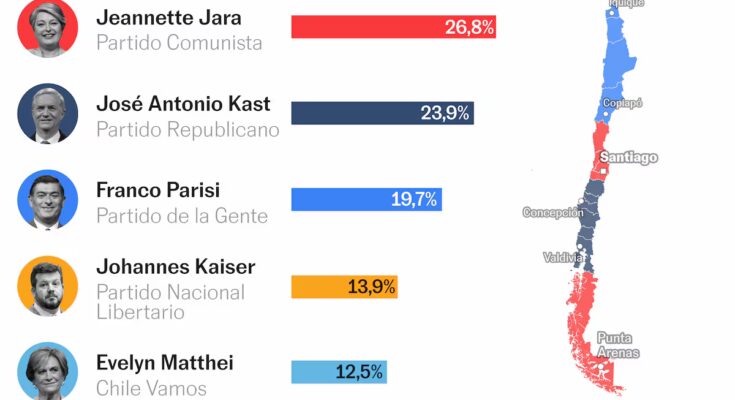Jeannette Jara, from the left, and José Antonio Kast, from the far right, were the most voted candidates in the first round of Chile’s presidential elections. Neither obtained an absolute majority of votes, so there will be a run-off on December 14.
Below we retrace the main graphs of this Sunday’s elections, the most popular in the history of Chile.
Jara wins, but would lose to Kast
The difference between Jara (26.8%) and Kast (23.9%) was smaller than the polls predicted. President Gabriel Boric’s former minister won by just three points. The big surprise was the third most voted, the populist Franco Parisi, who doubled the result assigned to him by the polls and obtained 19.7% of the votes. Against all odds, the candidate of the People’s Party (PDG) overtook the libertarian Johannes Kaiser (13.9%) and Evelyn Matthei (12.5%), representatives of the traditional right.
Looking at the second round, all the polls give José Antonio Kast’s victory as the most probable scenario. Votes for right-wing candidates this Sunday amounted to more than 51%. If we also added the votes that went to Parisi (he was Boric’s opponent, but it is not clear what his voters will choose), we would reach 70%.

What changes in Parliament
The Chileans also renewed the entire Chamber of Deputies (155 deputies) and practically half of the Senate (23 of the 50 senators from seven regions, which does not include the capital’s constituency). Here the parties are grouped into alliances.
The Cambio por Chile pact, which includes the formations that support Kast and also the libertarians that support Kaiser, would reach 53 deputies, according to the latest available data. Together with the traditional right (Chile Grande and Unidos), he obtains a majority with 76 parliamentarians in a chamber of 150. If he wins in December, Kast will have Parliament in his favor.

The Unidad por Chile government pact, which integrates the Socialist Party, the Broad Front and the Communist Party, among other center-left and left-wing political forces, has dropped from 72 to 55 deputies.
Participation: the effect of compulsory voting
This Sunday’s elections were the elections with the highest participation (85%) since the return of democracy in 1990. They were the first with compulsory voting and automatic census registration. The change incorporated five million new voters, who participated and risked fines of up to 105,000 Chilean pesos (around 100 euros).

The electoral map
The regional map was painted in three colors. Jara was the most voted candidate in six of Chile’s 16 regions, two in the south and some in the centre, including the metropolitan area of Santiago, the capital. Kast prevailed especially in the center and Parisi became strong in the northern regions.

Among the young people, Kast wins
Among young people, Kast was the most voted candidate, according to the latest poll published by AtlasIntel before the first round. One in three voters between 18 and 24 would have opted for this option. In fact, their preferences decrease as the age of the electorate increases. The opposite happens with Jara, who is elected by only 19% of young people but among those over sixty he receives more than half of the votes.

Jara clearly prevailed among both men (32%) and women (33%). Among Kast supporters there would be a slight advantage for women (21%) compared to men (18%). Paris, Matthei and Kaiser present more masculine profiles.

Pre-election polls also allow us to see where each candidate’s votes come from. The Chilean right did not agree and the electorate that supported Kast in the second round of 2021 (when he lost to Gabriel Boric) was divided between three options. Kast would have maintained 44% of the vote, but 25% of his voters at the time went with Kaiser and 19% with Matthei. On the other hand, 63% of those who voted for Boric supported Jara, well above the rest of the candidates. Parisi, the big surprise, would have managed to capture many of those who voted blank in 2021.




